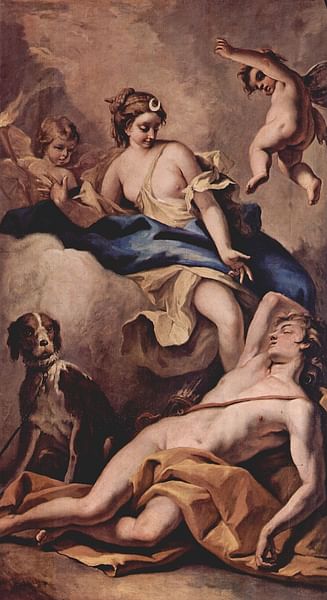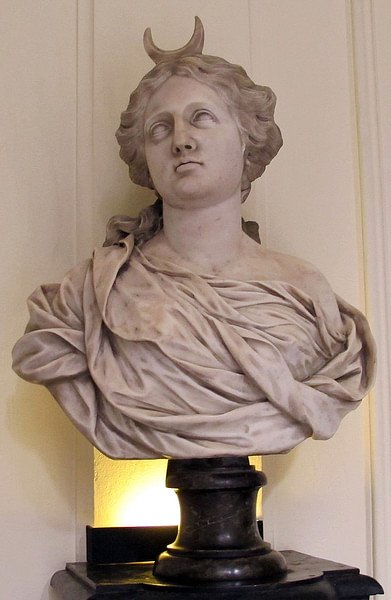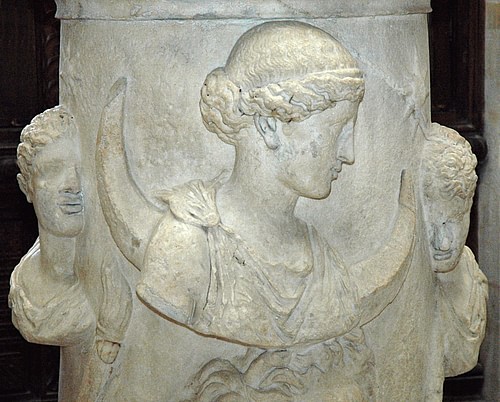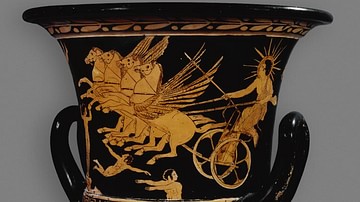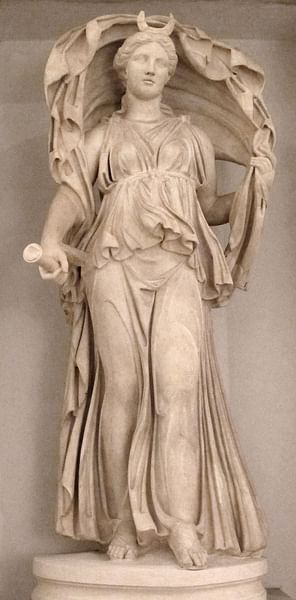
Selene (also known as Mene) is the personification and goddess of the moon in Greek mythology. Every night, she travels across the sky in her chariot, pulling the moon behind her. Selene is the daughter of the Titans Hyperion and Theia. She is commonly associated with the fellow Greek goddesses Artemis and Hecate. The Roman counterpart of Selene is Luna.
Birth & Family
According to Hesiod's (c. 700 BCE) Theogony, Selene is the daughter of the Titans Hyperion and Theia and the sister of Helios (Sun) and Eos (Dawn). She is also a descendant of Uranus (Heavens) and Gaia (Earth).
And Theia, mastered by Hyperion,
Bore Helios the great, bright Selene,
And Eos, who shines upon all men on earth
And on the deathless gods who hold broad heaven.(Hesiod, Theogony, 371-374)
Selene has two daughters with Zeus; Pandia (who the Athenians honoured every full moon) and Ersa (Herse), the personification of the dew.
Selene, the Moon Goddess
Selene, meaning "the moon", was depicted as a beautiful woman with long wings and a gold crown. Her crown shone a gentle light in the darkness of the night. Selene's moon chariot was pulled across the night sky by a pair of white-silvery horses or sometimes by a pair of oxen. She had a radiance that waxes and wanes with the different phases of the moon.
In the Orphic Hymn to Selene, she has horns. In the Homeric Hymn to Selene, Selene is described as a kindly and beautiful winged goddess who is crowned with gold and drives her chariot across the night sky as a sign to humans.
Glistening in heaven
from her immortal head,
a radiance encircles earth
and from her shining light
great beauty comes.
The air unlit before
glows with her golden crown
and her beams are bright as day.(The Homeric Hymns: Hymn to Selene, 32.4-7)
The moon was a powerful force in the ancient world. The moon's phases created the schedule of religious festivals celebrated throughout the year and symbolised the cycles of birth and death, with the ancient Greeks measuring out time in lunar months. Women in ancient Greece also had a special connection with the moon as it linked to their menstrual cycles, and the shape of a full moon echoed that of heavily pregnant women.
Some people believed that spirits lived on the moon, while neo-Plaonists believed that purified souls went to the moon after they had died. Another popular belief during the Classical Period was that witches could bring the moon down from the sky, linking Selene to witchcraft, which was further supported by the idea that magical herbs were usually collected and dried by moonlight. Therefore, some Roman and Greek writers associated her with Hecate, the goddess of magic.
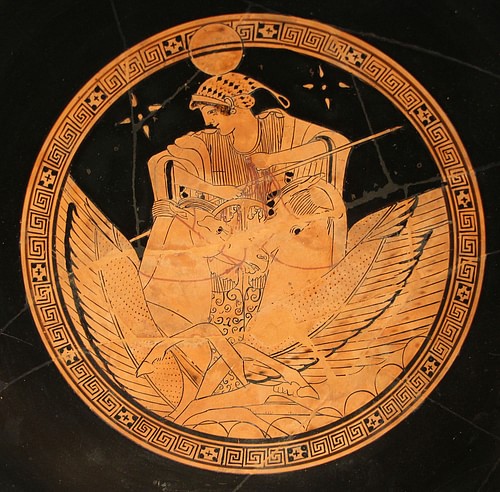
In Art
Throughout antiquity, Selene is portrayed on vases, reliefs, gems, and coins. In Greek art, Selene was usually depicted with a crescent moon crown and without wings. She was often seen with the moon and alongside her brother Helios flying across the sky – Selene on horseback and Helios in a chariot.
One of the most famous surviving depictions of Selene is the Greek sculpture by Phidias (d. c. 430 BCE) which can be found on the Parthenon in Athens. It shows Helios' chariot rising up on the eastern horizon (the sun rising), while on the other side, Selene and her horses are shown sinking over the west, symbolising their connection with the passing of time. Selene can also be found on the Pergamon Altar in a scene from the Gigantomachy. In an Attic red-figure kylix krater dating to 430 BCE, Selene is depicted with Helios, who drives a four-horse chariot, and Eos, who is on foot, while Selene is on horseback.
The Gigantomachy & Typhon
The only time Selene stopped pulling the moon across the night sky was at the orders of Hera and Zeus during the Giants' Revolt (Gigantomachy) against the Olympians. Hera had prophesied that the gods needed the help of a mortal (Heracles) to overthrow the gods. But first, they needed to locate a herb of invulnerability that grew in a secret place, so Hera forbade Selene and Helios to shine for a time. Under the low light of the stars, Zeus searched the earth for the herb and brought it back to heaven.
According to the Greek epic poet Nonnus (5th century CE) in his Dionysiaca, the monstrous serpent Typhon attacked Selene during his revolt against the heavens. He launched bulls at her, but she remained undaunted even after he charged at her. Selene struggled with Typhon, locking horns with him and scarring the orb of her bull's horn. Selene's cattle were wary of Typhon's gaping throat. Zeus finally defeated Typhon.
Selene & Endymion
The best-known story involving Selene is her love affair with the beautiful youth Endymion. As she was flying in her chariot over western Asia Minor (modern-day Turkey), Selene spotted the shepherd Endymion sleeping on a hill near Mount Latmos. Overcome by his beauty, she waited for the new moon when her chariot would not be seen and flew down to lie with him as he slept.
Selene bore Endymion 50 daughters. According to some sources, Selene begged Zeus to grant Endymion perpetual sleep, so he would not age or die and so she could watch him sleep peacefully each night. Other sources state that Endymion chose it for himself, while some say that it was Selene's punishment from Zeus for being absent from the skies.
Selene & Pan
Magic played a part in another one of Selene's relationships. The mischievous god Pan disguised himself by covering his short, coarse black goat hair with soft, clean white fleece. Not realising his true identity, Selene climbed onto his back and permitted him to do whatever he wanted to her. Pan's seduction of Selene has ties to the May Eve festival, where the young Queen of the May rode upon her lover's back before taking part in a greenwood marriage ceremony.
Selene's Revenge
A common theme seen amongst the Greek deities is how quick they are to rise to anger when they are beaten at something or if somebody challenges their powers or talents. This was the case with Ampelos, a youth who Dionysos was enamoured with. Dionysos arranged multiple sporting competitions and was so in love with Ampelos that he let him win each one. Unfortunately, this resulted in Ampelos becoming overconfident.
One day, he foolishly stated that he was better at riding a wild bull than Selene was at riding her horned moon. Selene chose his punishment carefully. She sent down a gadfly that stung the wild bull Ampelos was riding. The crazed bull threw Ampelos from its back and attacked him. Dionysos rushed to Ampelos' side but could not save him. Dionysos transformed Ampelos' mangled body into a winding climbing plant where his blood turned into luscious berries.
Selene & Heracles
Selene was featured briefly in the story of Heracles, where she played a minor part in his being conceived. Zeus had fallen in love with the human Alcmene. To be able to visit her, he needed a long night to ensure that he went unseen. He instructed Hypnos (Sleep) to make all humans so tired that they would not notice that Helios (Sun) did not rise and that Selene moved extra slowly across the night sky, dragging out the night. Then, disguising himself as Alcmene's husband, Amphitryon, he snuck into Alcmene's chambers. Sleeping with both Zeus and her husband, Alcmene became pregnant with twins – Heracles with Zeus and Iphicles with her husband.
Selene is also credited with creating the ferocious Nemean Lion, whom Heracles faced in his first labour. The Nemean Lion was a giant beast whose fur could not be penetrated by iron, stone or bronze weapons. Some traditions state that Selene bore the lion with a shudder and dropped it to earth near Nemea by a two-mouthed cave, where she made the creature prey upon her own people as punishment for an unfulfilled sacrifice.
Other sources say that in answer to Hera's wishes, Selene created the lion from sea foam which was then bound and carried to the Nemean mountains by Iris, the personification of the rainbow, before Heracles faced it.
Worship & Legacy
In his Description of Greece, the Greek geographer Pausanias (c. 115 to c. 180 CE) talks about a stone image of a horned Selene in Elis' agora (open-air marketplace) in southern Greece. According to the work of Pseudo-Plutarch in their De fluviis, Mount Apesantus used to be named Mount Selenaeus (moon mountain) after Selene.
Moon-shaped cakes were made in honour of Selene. According to the Greek historian Philochorus (340-261 BCE), the ancient Attic Tritopatores (a group of worshipped ancestors) were created by the union between the moon and sun, and the Athenians prayed to them. Greek poet Pindar (c. 518 to c. 448 BCE) stated that men in love prayed to the sun (Helios), while women in love prayed to the moon (Selene). Evidence of the worship of Selene and Helios could be found in an inscription in Gythium (the Peloponnese). Diogenes of Sinope (c. 404-323 BCE) dedicated altars to Selene, Apollo, Asclepius, and Hygieia at Epidaurus in the Asclepieion.
In astronomy, the asteroid 580 Selene is named in honour of her. It orbits the Sun between Mars and Jupiter. In chemistry, the chemical element selenium was named after Selene in 1818 by the Swedish chemist Jöns Jacob Berzelius (1779-1848).


